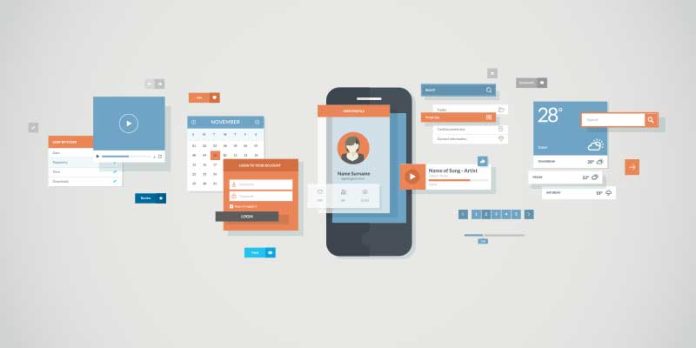Table of Contents:
- Introduction
- What is a Responsive User Interface?
- Why is a Responsive User Interface Important for Android Apps?
- How to Build a Responsive User Interface for Android Apps: Step by Step Process
- Best Practices for Building a Responsive User Interface for Android Apps
- Tips for Working with a Mobile App Development Company in USA
- FAQs
- Conclusion
Introduction
In the era of mobile devices, where smartphones have become a vital part of everyone’s life, mobile app development companies in the USA are in a constant effort to create apps with a great user interface. Android app development is no exception. If you’re looking to build an Android app, you’ll need to create a responsive user interface that provides a seamless experience for your users. In this blog post, we’ll explore what a responsive user interface is, why it’s important for Android apps, and how you can build one with the help of the best mobile app development company in USA. We’ll also share some best practices and tips for working with an Android App Development Agency.
What is a Responsive User Interface?
A responsive user interface is one that adjusts to the size and orientation of the device it’s being viewed on. This means that whether your app is being viewed on a phone or a tablet, in portrait or landscape mode, the interface remains easy to use and navigate. A responsive user interface is achieved through the use of fluid layouts, flexible images and text, and media queries that adjust the display based on the device and screen size. In other words, a responsive user interface ensures that the layout and content of a website or app will automatically adjust to fit the size of the screen on which it is being viewed, whether it’s a desktop computer, laptop, tablet, or smartphone. This allows users to access and interact with the application easily and efficiently, regardless of the device they are using.
Why is a Responsive User Interface Important for Android Apps?
A responsive user interface is important for Android apps because it ensures that your app is accessible and usable on a wide variety of devices. If your app isn’t responsive, it may be difficult to use on smaller screens or in different orientations. This can lead to a frustrating user experience and ultimately result in users abandoning your app. By building a responsive user interface, you can ensure that your app is accessible and usable for all of your users. Developing an Android app with a responsive user interface ensures that the app’s design will adapt to the specific device it’s being used on, providing a consistent and intuitive experience for users. This is especially important for mobile apps, where users are frequently accessing the app on-the-go and using a variety of different devices. A responsive user interface also improves the app’s usability and accessibility. With a responsive design, users can access all the features of the app without having to pinch, zoom, or scroll excessively. This can improve engagement and encourage users to spend more time using the app.
How to Build a Responsive User Interface for Android Apps: Step by Step Process
Building a responsive user interface for Android apps requires careful planning and design. Here are some important steps to follow:
- Define your design goals: Before starting to build your app, it’s important to define your design goals and determine what features and functionality you want to include. This will help you create a clear vision for your app and ensure that your design is tailored to the needs of your users.
- Use responsive design principles: When designing your app, use responsive design principles to ensure that the app’s layout and content can adapt to different screen sizes and resolutions. This includes using flexible grids, scalable images, and font sizes that can adjust based on the device being used.
- Test on multiple devices: It’s important to test your app on multiple devices with different screen sizes and resolutions to ensure that your design works well across all platforms. This will help you identify any issues or inconsistencies in your design and make necessary adjustments.
- Prioritize functionality: When designing your app, prioritize functionality over aesthetics. This means focusing on creating a user-friendly interface that’s easy to navigate and provides a seamless experience for users, rather than simply creating a visually appealing design.
- Consider user feedback: Once your app is live, gather feedback from users and use this information to make improvements to your design. This will help you identify areas where your app may be falling short and make necessary changes to improve the user experience.
By following the above mentioned steps, you can create a responsive user interface for your Android app that meets the needs and preferences of your users, regardless of the device they are using.
Best Practices for Building a Responsive User Interface for Android Apps:
To Build responsive user interface for Android apps requires following some best practices, like:
- Use a grid-based layout: A grid-based layout provides a flexible foundation for your app’s design, allowing it to adjust to different screen sizes and resolutions. Use a grid system to organize content and elements on the screen, and ensure that the layout remains consistent across devices.
- Optimize images and media: Optimize images and media files to ensure that they load quickly and don’t slow down your app’s performance. Use appropriate image file types and sizes, and consider using lazy loading techniques to improve loading times.
- Minimize the number of elements on each screen: A cluttered screen can make it difficult for users to navigate and interact with your app. Minimize the number of elements on each screen and prioritize the most important content.
- Use appropriate font sizes: Use font sizes that are appropriate for the device being used. This ensures that text remains legible and doesn’t require excessive zooming or scrolling.
- Test on multiple devices and orientations: Test your app on a variety of devices and orientations to ensure that your design works well across all platforms. This will help you identify any issues or inconsistencies in your design and make necessary adjustments.
- Use responsive navigation: Use responsive navigation techniques that adjust based on the device being used. This can include using a hamburger menu on mobile devices and a more traditional menu on larger screens.
- Prioritize accessibility: Ensure that your app is accessible to users with disabilities by following accessibility guidelines and standards. This can include using alt text for images and providing options for users to adjust font sizes and color contrast.
Tips for Working with a Mobile App Development Company in USA:
USA is a country of innovation and technology which houses some of the best mobile app development companies in the world, a lot of organizations prefer USA based developers rather than the others. Here are some of the tips which one must follow to work with a mobile app development company in USA.
- Look for a company with experience in building responsive user interfaces for Android apps.
- Check out their portfolio to see examples of their work and ensure that they can deliver the quality you’re looking for.
- Communicate your goals and expectations clearly, and make sure that you’re on the same page before starting development.
- Stay involved throughout the development process, providing feedback and making adjustments as needed.
- Test your app thoroughly before launch to ensure that it looks and functions properly on a wide range of devices.
Conclusion
Building a responsive user interface for Android apps is essential for creating a seamless user experience. By following the tips and best practices mentioned in this blog post, you can build a responsive UI that adapts to different screen sizes, resolutions, and orientations. This helps to improve user engagement, retention, and ultimately, conversions. Remember to use custom views, optimize image sizes, design for multiple screen densities, and test the app on real devices to ensure responsiveness.
FAQs
What is a responsive user interface in Android app development?
A responsive user interface is an interface that adjusts and adapts to different device screen sizes and orientations, providing a seamless user experience across all devices.
How can custom mobile app development services help in building a responsive user interface?
Custom mobile app development services can help in building a responsive user interface by providing access to experienced UI/UX designers and developers who can implement best practices and design principles to ensure the app is optimized for different screen sizes and resolutions.
What are some best practices for designing a responsive Android UI?
Some best practices for designing a responsive Android UI include using scalable vector graphics, optimizing image sizes, designing for multiple screen densities, and testing the app on real devices to ensure responsiveness.
How can I measure the responsiveness of an Android app?
One way to measure the responsiveness of an Android app is to use profiling tools like Android Studio’s profiler, which can measure the app’s CPU usage, memory usage, and frame rate.
How can I ensure my Android app’s UI is accessible to users with disabilities?
To ensure your Android app’s UI is accessible to users with disabilities, you can follow accessibility guidelines and principles, such as providing alternative text for images, using high contrast colors, and ensuring the app can be navigated using keyboard controls.








